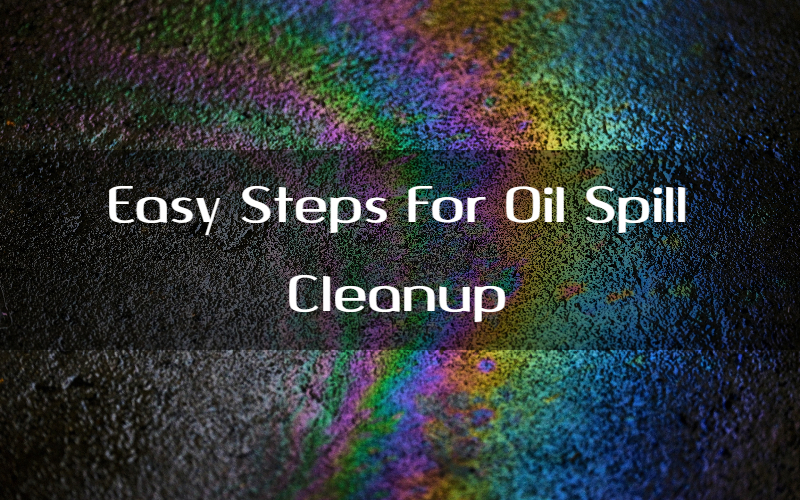Easy Steps For Oil Spill Cleanup
In this article, we discuss the most common methods used to clean up oil spills at sea. So-called absorbents act like a sponge that soaks up oil. In-situ burning was used during the explosion at the Deepwater Horizon drilling site.
There are 7 most common methods for oil spill cleanup :
- Oil Booms
Did you recognize that one-third of the world’s oil comes from offshore drilling sites? whereas most offshore rigs never run into any problems, now and again damage to either the structure or drill itself leads to oil spilling into the ocean.
In these cases, the oil booms will save the situation by trapping the oil. They feature 3 main parts:
- A freeboard for trapping the oil rising on top of the water surface.
- The second component is named a “skirt” placed underneath the freeboard below the water surface that acts as the barrier wall.
- Let’s not forget a chain or cable that connects the elements to strengthen and stabilize the boom.
By the way, the booms can not be used everywhere. This device is appropriate to get rid of oil spills from a single area. A lot of oil is spilled within the ocean, the less effective is the method.
- Sorbents
The word sorbent may sound unfamiliar. We are going to offer you with its meaning. Once the oil is spilled within the ocean, 2 kinds of sorbents is used to clean up the spill. The absorbents that absorb the oil and therefore the adsorbents that don’t soak up the oil however form a layer on the surface instead.
Materials usually used as oil sorbents are straw, corncob, or peat moss. Their advantage is their organic nature. The disadvantage is that they absorb only three to fifteen times their weight.
Synthetic materials, with their capability to soak up seventy times their weight, are better sorbents. Researchers at Argonne National Lab have developed an excellent simpler material that may absorb up to ninety times its weight in 2017. Not like natural sorbents, {which can|which may|which may} be used only once, this “sponge” made from polyurethane is reused.
The sorbents, a bit like the oil containment booms, even have many disadvantages, such as that they’re difficult to retrieve. Within the worst-case scenario, the sorbents might sink under its own weight and create a risk to aquatic life.
- Skimmers
If the oil can’t be soaked up, skimmers mounted on the sting of the boat are next to be deployed. These devices are specially designed to suck up the water from the water surface.
Even better, they’ll separate the water and oil, creating the oil re-usable. As for the disadvantages, the presence of rubbish prevents their use as they can get clogged, and therefore become unusable.
- High-pressure washing
This technique serves the aim of “flushing” instead of cleanup the water. Imagine a hot-water tank that heats up the water to 170°C. The new water is then sprayed with aggressive nozzles on areas with trapped oil.
The pressure flushes the oil to the water surface which may be collected with skimmers or booms. This procedure is especially applied in situations where the oil is inaccessible to larger machinery, such as on the beach.
It’s not the most effective choice for seas since the high pressure may disperse the oil, contaminate clean water with oil, and put marine life in danger.
- In-situ burning
The Gulf of Mexico Oil Spill on the Deepwater Horizon drilling site occurred in 2010. The in-situ burning has been used to remove the oil. The procedure is easy: the oil floating on the surface is ignited to burn it off. The burning is subject to strict supervision. In-situ burning is much more effective compared to other methods of oil spill clean-up. It can remove up to 98% of oil.
However, it cannot be used at every accident. The spill thickness must be at least 3mm on the surface to be burned. Thinner layers are more difficult to remove, sometimes even impossible. Unfavorable weather conditions are also not compatible with the in-situ burning.
- Gelatin treatment
Gelatinizing is the method of making use of agent in powdered shape to grease spills on water. The compound confines the oil and creates a extra stable gelatin, and hence separates the oil from water. The oil-gelatin compound is later gathered via way of means of nets and skimmers.
This approach is powerful, but difficult to apply. The oil and gelatin ratio is 1:3 this means that you want 3 times the quantity of gelatin to do away with the oil. For a few injuries, this isn’t possible.
- Bioremediation
It is based on the usage of particular microorganisms released to the water, which includes bacteria, algae and fungi. Their motive is to break the oil into simpler and non-poisonous molecules. In order for the approach to be as effective as possible, the fungi or algae need to be as huge as possible. Reagents and fertilizers may be delivered to the tainted water to facilitate the growth of the above.
